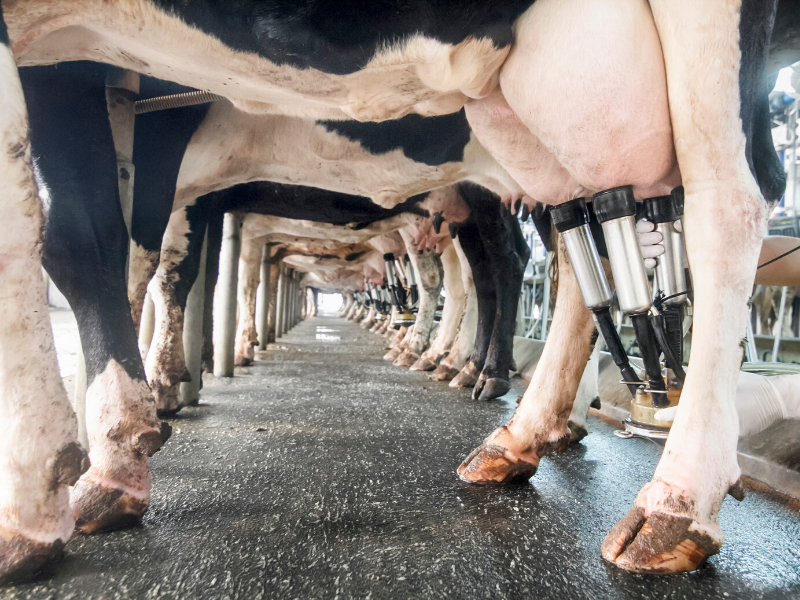
Has the inevitable drop in fat and protein % hit your bulk tank results? This occurs this time every spring as the milk yields increase in spring calving dairy herds. Milk fat and protein are at their highest concentration in the colostrum after calving and decrease from calving to reach a minimum level when cows reach peak milk yield 4-6 weeks after calving. These decreases are due to the natural dilution effect that occurs as cows reach peak milk yield but may also be influenced by a number of other factors. A large drop in either fat or protein will affect the price that you receive from your Co-Op. If fat falls below 3.6% and/or protein falls below 3.3% then your milk price will be below the base price. Normally milkfat is higher than protein with the ratio ideally above 1.15: 1.
Low Milk Protein
Milk protein is affected by numerous factors – genetics, stage of lactation, age, body condition, nutrition and weather. These factors can affect protein independently or a combination of these factors can result in a reduction in protein %. As a result there is no silver bullet for fixing low protein. Nutritionally it is hard to make big changes to the protein. Very low milk proteins (<3.10%) are directly related to the energy supply and underfeeding of cows. Underfed cows will milk of their backs short term and will drop protein % quickly. The problem can seem a lot worse in herds that have a very compact calving pattern. These herds will have a very low protein % trough compared with herds with a more spread-out calving pattern as more cows will be peaking together.
Milk protein will increase slowly if feeding improves but will not recover fully. Getting grazed grass into cows is important as it is much better feed for protein than silage however protein will drop if grass is scarce and not supplemented. High energy concentrates will help but feeding enough concentrate is most important when grass is scarce.
Using high protein concentrates will not help with the protein % in milk but can depress protein % where energy supply is the real problem. High starch levels (Maize and Barley) in concentrates fed will help with energy for protein production.
Low Milk Fat
Milk fat is made up of fatty acids which are made in the udder and other fatty acids that arise predominately from the diet. Two things must happen together for low fat to be experienced. 1) An altered rumen environment – This limits fibre digestion
2) Increased supply of unsaturated fatty acids in the diet.
A low rumen pH will alter rumen function and reduce fibre digestion. Normally in the rumen unsaturated fatty acids from the diet are utilised using a particular pathway. However when the pH in the rumen is reduced the pathway changes to produce unique fatty acids some of which are potent inhibitors of fat synthesis in the udder. Spring grass provides the ingredients for low milk fat as it is low in structural fibre and high in sugars which can lead to a drop in rumen pH which leads to sub-acute rumen acidosis. A solution to this problem is to offer cows long fibre in the form of hay or chopped straw. This will increase fibre intake, rumination and saliva production.
Elevated intake of unsaturated fats from young leafy grass in spring with up to 5% of DM of fresh grass made up of unsaturated fatty acids. They are toxic to rumen bacteria and in order for to survive, the bacteria carry out a process called biohydrogenation. This process creates by-products that stop the udder from producing fat leading to low milk fat %. Even 2g of the by-products making their way to the udder can reduce milk fat by 0.4%.
To minimise the fatty acids in spring grass avoid grazing very low covers (<1,300 kg DM/Ha). Graze swards when they have reached the 3-leaf stage. Don’t blanket spread fertiliser as levels of fatty acids will increase rapidly after nitrogen application. Spread fertiliser after cow’s graze paddocks.
There is no single cause for low milk fat and as a result the solution needs to be a multi-structured approach. It is very difficult to control the oil intake on full time grazing diets. Any nutritional or management change that you make to try and improve low milk fats will take 7- 10 days before you see a change in the bulk tank results.
To help with lush spring grass this spring Rhyno Mills have formulated the new Rhyno Supreme Solids 15% Dairy Nut. The nut has high UFL content with Maize and Barley the first two ingredients. We have also included Equaliser rumen buffer to help maintain rumen stability and avoid the drop in rumen pH which can interfere with fibre digestion and milk fat production. Optitek is also included which is a unique combination of plant extracts and essential oils that improve microbial fermentation in the rumen. The nut also contains a high spec fertility mineral package in preparation for the breeding season with high levels of vitamins, protected sources of copper, zinc and selenium. For more information call the Rhyno Office on 066-7141205 or your local sales representative.
